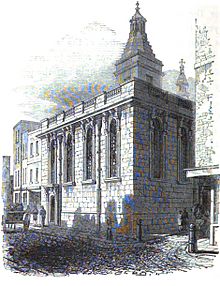St Mary Magdalen Old Fish Street
| St. Mary Magdalen Old Fish Street | |
|---|---|
 |
|
| Location | Old Fish Street and Old Change, London |
| Country | England |
| Denomination | Church of England |
| Architecture | |
| Architect(s) | Christopher Wren |
| Style | Baroque |
| Demolished | 1893 |
St. Mary Magdalen Old Fish Street was a church in Castle Baynard ward of the City of London, England, located on the corner of Old Fish Street and Old Change, on land now covered by post-War development. Recorded since the 12th century, the church was destroyed in the Great Fire of London of 1666, then rebuilt by the office of Sir Christopher Wren. The rebuilt church suffered damage to its roof from a fire in an adjacent warehouse in 1886. It was not repaired and finally demolished in 1893.
St. Mary Magdalen Old Fish Street was the only one of the 8 churches in the post-Fire City of London, called “St. Mary” dedicated to the penitent Mary Magdalene, rather than the Virgin Mary. Old Fish Street formerly ran from the Thames towards St. Paul’s Cathedral and was the location of a fish market since medieval times. The street was incorporated into Knightrider Street in 1872.
The earliest surviving reference to the church is in a document of 1181, as “St Mary Magdalen”. Other medieval records refer to the church as “St. Marie Magdal in Piscaria apud sanctum Paulum”, "St. Marie Magdal parish at the Fishmarket”, "St. Marie Magdalen Eldefisshestrete" and “St. Mary Magdalen at Lamberdyshel”.
Among the memorials in the pre-Fire church was a brass plaque of 1586, commemorating the merchant and benefactor, Thomas Berrie. The plaque survived the Great Fire and may now be seen in St Martin, Ludgate. In part it reads:
St Martin, Ludgate also has the bread shelves from St. Mary Magdalen Old Fish Street.
On Easter Day, 1653, John Evelyn recorded in his Diary that he and his family received Holy Communion at St. Mary Magdalen’s. This was during the Protectorate when Anglican services were banned.
The church was destroyed in the Great Fire in 1666 and the parish combined with that of St. Gregory-by-St. Paul’s, which was not rebuilt. Building of the new church began in 1683, with new foundations for the north wall and tower, but incorporating some of the old walls elsewhere. The work was completed in 1687 at a total cost of £4315.
...
Wikipedia
